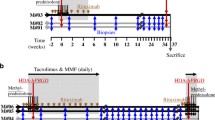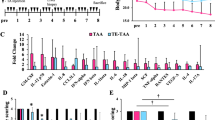Abstract
Pre-existing immune response against adenovirus could diminish transgene expression efficiency when Ad is employed in humans as gene therapy vector. We previously used Ad-hΔuPA (Recombinant adenovirus expressing human urokinase-type plasminogen activator) as antifibrotic gene therapy in cirrhosis models and demonstrated its effectiveness. As a further clinical approach, transient Cyclosporine A (CsA) immunosuppression was induced in cirrhotic animals to determine whether Ad-hΔuPA administration retained efficacy. Adenovirus sensitization was achieved by systemic administration of non-therapeutic Ad-βGal (Recombinant adenovirus expressing beta-galactosidase) after 4 weeks of intraperitoneal carbon tetrachloride (CCl4) regimen. Cirrhosis induction continued up to 8 weeks. At the end of CCl4 intoxication, immunosuppression was achieved with three CsA doses (40 mg/kg) as follows: 24 h before administration of Ad-hΔuPA, at the moment of Ad-hΔuPA injection and finally, 24 h after Ad-hΔuPA inoculation. At 2 and 72 h after Ad-hΔuPA injection, animals were sacrificed. Liver, spleen, lung, kidney, heart, brain, and testis were analyzed for Ad-biodistribution and transgene expression. In naïve animals, Ad-hΔuPA genomes prevailed in liver and spleen, while Ad-sensitized rats showed Ad genomes also in their kidney and heart. Cirrhosis and Ad preimmunization status notably diminished transgene liver expression compared to healthy livers. CsA immunosuppression in cirrhotic animals has no effect on Ad-hΔuPA biodistribution, but increments survival.





Similar content being viewed by others
References
Yadvinder, S. A., Dinesh, S. B., & Suresh, K. M. (2011). Adenoviral vector immunity: Its implications and circumvention strategie. Current Gene Therapy,11(4), 307–320.
Tomita, K., Sakurai, F., Tachibana, M., & Mizuguchi, H. (2012). Correlation between adenovirus-neutralizing antibody titer and adenovirus vector-mediated transduction efficiency following intratumoral injection. Anticancer Research,32(4), 1145–1152.
Sack, B. K., & Herzog, R. W. (2009). Evading the immune response upon in vivo gene therapy with viral vectors. Current Opinion in Molecular Therapeutics,11(5), 493–503.
Cao, H., Yang, T., Li, X. F., Wu, J., Duan, C., Coates, A. L., et al. (2011). Readministration of helper-dependent adenoviral vectors to mouse airway mediated via transient immunosuppression. Gene Therapy,18, 173–181.
Chirmule, N., Raper, S. E., Burkly, L., Thomas, D., Tazelaar, J., Hughes, J. V., et al. (2000). Readministration of adenovirus vector in nonhuman primate lungs by blockade of CD40-CD40 ligand interactions. Journal of Virology,74, 3345–3352.
Unzu, C., Melero, I., Hervás-Stubbs, S., Sampedro, A., Mancheño, U., Morales-Kastresana, A., et al. (2015). Helper-dependent adenovirus achieve more efficient and persistent liver transgene expression in non-human primates under immunosuppression. Gene Therapy,22, 856–865.
Kay, M. A., Meuse, L., Gown, A. M., Linsley, P., Hollenbaugh, D., Aruffo, A., et al. (1997). Transient immunomodulation with anti-CD40 ligand antibody and CTLA4Ig enhances persistence and secondary adenovirus-mediated gene transfer into mouse liver. Proceedings of the National Academy of Sciences of the United States of America,94, 4686–4691.
Ilan, Y., Jona, V. K., Sengupta, K., Davidson, A., Horwitz, M. S., Roy-Chowdhury, N., et al. (1997). Transient immunosuppression with FK506 permits long-term expression of therapeutic genes introduced into the liver using recombinant adenoviruses in the rat. Hepatology,26, 949–956.
Shen, W. Y., Lai, M. C., Beilby, J., Barnett, N. L., Liu, J., Constable, I. J., et al. (2001). Combined effect of cyclosporine and sirolimus on improving the longevity of recombinant adenovirus-mediated transgene expression in the retina. Archives of Ophthalmology,119, 1033–1043.
Vilquin, J. T., Guerette, B., Kinoshita, I., Roy, B., Goulet, M., Gravel, C., et al. (1995). FK506 immunosuppression to control the immune reactions triggered by first-generation adenovirus-mediated gene transfer. Human Gene Therapy,6, 1391–1401.
Fontanellas, A., Hervás-Stubbs, S., Mauleón, I., Dubrot, J., Mancheño, U., Collantes, M., et al. (2010). Intensive pharmacological immunosuppression allows for repetitive liver gene transfer with recombinant adenovirus in nonhuman primates. Molecular Therapy,18(4), 754–765.
Fang, B., Eisensmith, R. C., Wang, H., Kay, M. A., Cross, R. E., Landen, C. N., et al. (1995). Gene therapy for hemophilia B: Host immunosuppression prolongs the therapeutic effect of adenovirus-mediated factor IX expression. Human Gene Therapy,6, 1039–1044.
Durham, H. D., Alonso-Vanegas, M. A., Sadikot, A. F., Zhu, L., Lochmuller, H., Massie, B., et al. (1997). The immunosuppressant FK506 prolongs transgene expression in brain following adenovirus-mediated gene transfer. NeuroReport,8, 2111–2115.
Garcia-Banuelos, J., Siller-Lopez, F., Miranda, A., Aguilar, L. K., Aguilar-Cordova, E., & Armendariz-Borunda, J. (2002). Cirrhotic rat livers with extensive fibrosis can be safely transduced with clinical-grade adenoviral vector. Evidence of cirrhosis reversion. Gene Therapy,9, 127–134.
Salgado, S., Garcia, J., Vera, J., Siller, F., Bueno, M., Miranda, A., et al. (2000). Liver cirrhosis is reverted by urokinase-type plasminogen activator gene therapy. Molecular Therapy,2, 545–551.
Miranda-Diaz, A., Rincon, A. R., Salgado, S., Vera-Cruz, J., Galvez, J., Islas, M. C., et al. (2004). Improved effects of viral gene delivery of human uPA plus biliodigestive anastomosis induce recovery from experimental biliary cirrhosis. Molecular Therapy,9, 30–37.
Perez, T. R. (1983). Is cirrhosis of the liver experimentally produced by CCl4 and adequate model of human cirrhosis? Hepatology,3, 112–120.
Armendáriz-Borunda, J., Bastidas-Ramírez, B. E., Sandoval-Rodríguez, A., González-Cuevas, J., Gómez-Meda, B., & García-Bañuelos, J. (2011). Production of first generation adenoviral vectors for preclinical protocols: amplification, purification and functional titration. Journal of Bioscience and Bioengineering,112, 415–421.
Sitz, K. V., & Birx, D. L. (1999). Lymphocyte proliferation assay. Methods in Molecular Medicine,17, 343–353.
Ishak, K., Baptista, A., Bianchi, L., Callea, F., De Groote, J., Gudat, F., et al. (1995). Histological grading and staging of chronic hepatitis. Journal of Hepatology,22, 696–699.
Recknagel, R. O., Glende, E. A., Dolak, J. A., & Waller, R. L. (1989). Mechanisms of carbon tetrachloride toxicity. Pharmacology & Therapeutics,43, 139–154.
Tomita, K., Sakurai, F., Iizuka, S., Hemmi, M., Wakabayashi, K., Machitani, M., et al. (2018). Antibodies against adenovirus fiber and penton base proteins inhibit adenovirus vector-mediated transduction in the liver following systemic administration. Science Reports,8, 12315–12327.
Klasse, P. J. (2018). Collusion between neutralizing antibodies and other immune factions in the destruction of adenoviral vectors. Proceedings of the National Academy of Sciences of the United States of America,115, 10201–10203.
Arruda, V. R., Favaro, P., & Finn, J. D. (2009). Strategies to modulate immune responses: A new frontier for gene therapy. Molecular Therapy,17(9), 1492–1503. https://doi.org/10.1038/mt.2009.150.
Harvey, B. G., Maroni, J., O'Donoghue, K. A., Chu, K. W., Muscat, J. C., Pippo, A. L., et al. (2002). Safety of local delivery of low- and intermediate-dose adenovirus gene transfer vectors to individuals with a spectrum of morbid conditions. Human Gene Therapy,13, 15–63.
Liu, Q., & Muruve, D. A. (2003). Molecular basis of the inflammatory response to adenovirus vectors. Gene Therapy,10, 935–940.
Meier, O., & Greber, U. F. (2004). Adenovirus endocytosis. Journal of Gene Medicine,6, S152–163.
Ganesan, L. P., Mohanty, S., Kim, J., Clark, K. R., Robinson, J. M., & Anderson, C. L. (2011). Rapid and efficient clearance of blood-borne virus by liver sinusoidal endothelium. PLoS Pathogens,7(9), e1002281.
Zhang, Y., Chirmule, N., Gao, G. P., Qian, R., Croyle, M., Joshi, B., et al. (2001). Acute cytokine response to systemic adenoviral vectors in mice is mediated by dendritic cells and macrophages. Molecular Therapy,3, 697–707.
Jooss, K., Yang, Y., Fisher, K. J., & Wilson, J. M. (1998). Transduction of dendritic cells by DNA viral vectors directs the immune response to transgene products in muscle fibers. Journal of Virology,72, 4212–4223.
Schiedner, G., Bloch, W., Hertel, S., Johnston, M., Molojavyi, A., Dries, V., et al. (2003). A hemodynamic response to intravenous adenovirus vector particles is caused by systemic Kupffer cell-mediated activation of endothelial cells. Human Gene Therapy,14, 1631–1641.
Smith, J. S., Tian, J., Muller, J., & Byrnes, A. P. (2004). Unexpected pulmonary uptake of adenovirus vectors in animals with chronic liver disease. Gene Therapy,11, 431–438.
Awasthi, V., Meinken, G., Springer, K., Srivastava, S., & Freimuth, P. (2004). Biodistribution of radioiodinated adenovirus fiber protein knob domain after intravenous injection in mice. Journal of Virology,78, 6431–6438.
Smith, J. S., Tian, J., Lozier, J. N., & Byrnes, A. P. (2004). Severe pulmonary pathology after intravenous administration of vectors in cirrhotic rats. Molecular Therapy,9, 932–941.
Varnavski, A. N., Zhang, Y., Schnell, M., Tazelaar, J., Louboutin, J. P., Yu, Q. C., et al. (2002). Preexisting immunity to adenovirus in rhesus monkeys fails to prevent vector-induced toxicity. Journal of Virology,76, 5711–5719.
Vlachaki, M. T., Hernandez-Garcia, A., Ittmann, M., Chhikara, M., Aguilar, L. K., Zhu, X., et al. (2002). Impact of preimmunization on adenoviral vector expression and toxicity in a subcutaneous mouse cancer model. Molecular Therapy,6, 342–348.
Thomas, C. E., Schiedner, G., Kochanek, S., Castro, M. G., & Lowenstein, P. R. (2001). Preexisting antiadenoviral immunity is not a barrier to efficient and stable transduction of the brain, mediated by novel high-capacity adenovirus vectors. Human Gene,12, 839–846.
Harvey, B. G., Hackett, N. R., El-Sawy, T., Rosengart, T. K., Hirschowitz, E. A., Lieberman, M. D., et al. (1999). Variability of human systemic humoral immune responses to adenovirus gene transfer vectors administered to different organs. Journal of Virology,73, 6729–6742.
Seregin, S. S., & Amalfitano, A. (2010). Improving adenovirus based gene transfer: Strategies to accomplish immune evasion. Viruses,2(9), 2013–2036.
Lochmuller, H., Petrof, B. J., Pari, G., Larochelle, N., Dodelet, V., Wang, Q., et al. (1996). Transient immunosuppression by FK506 permits a sustained high-level dystrophin expression after adenovirus-mediated dystrophin minigene transfer to skeletal muscles of adult dystrophic (mdx) mice. Gene Therapy,3, 706–716.
Pedroso Baretta, G. A., Gama, F. O., Toderke, E. L., Dall'Oglio Tolazzi, A. R., & Fouto Matias, J. E. (2015). Effect of cyclosporine on liver regeneration in partial hepatectomized rats. Acta Cirurgica Brasileira,30(1), 54–59.
Smith, T. A., White, B. D., Gardner, J. M., Kaleko, M., & McClelland, A. (1996). Transient immunosuppression permits successful repetitive intravenous administration of an adenovirus vector. Gene Therapy,3(6), 496–502.
Acknowledgements
Authors want to thank Conacyt for Grant Number 103772 awarded to Ana Sandoval Rodriguez and Conacyt Grant Number 259096 awarded to Juan Armendariz-Borunda
Author information
Authors and Affiliations
Corresponding author
Ethics declarations
Conflict of interest
All authors declare that they have no conflict of interest.
Ethical Approval
All applicable international, national, and/or institutional guidelines for the care and use of animals were followed. All procedures performed in studies involving animals were in accordance with the ethical standards of the institution or practice where the studies were conducted. The protocol was approved by the Research and Ethical Committee of the CUCS, Universidad de Guadalajara (Approval Number C.I. 67-2012) which reviewed and approved the mortality aspects of the protocol.
Additional information
Publisher's Note
Springer Nature remains neutral with regard to jurisdictional claims in published maps and institutional affiliations.
Rights and permissions
About this article
Cite this article
Sandoval-Rodríguez, A., Mena-Enriquez, M., García-Bañuelos, J. et al. Adenovirus Biodistribution is Modified in Sensitive Animals Compared to Naïve Animals. Mol Biotechnol 62, 260–272 (2020). https://doi.org/10.1007/s12033-020-00247-x
Published:
Issue Date:
DOI: https://doi.org/10.1007/s12033-020-00247-x




